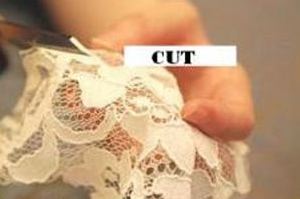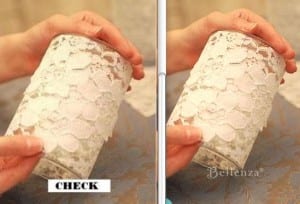Image Watermark Hijacking

Update: Minor corrections to the article to remove the name.
When it comes to matters of image protection, one usually has to think about shifting gears. Where text nearly impossible to protect but can be trivially tracked and monitored for reuse, with images it is more important to be proactive, including watermarks on images, adding appropriate metadata and being sure to register your work with services that help identify you as the author.
However, the owner of Bellenza.com recently contacted me about an unusual kind of visual plagiarism that actually defeats even visible watermarks, but at the cost of ruining the image. The site, which sells wedding accessories, party favors and decorations, had several images from its decorating blog used on a WordPress.com blog but the ever-present watermark was gone.
Instead, where the watermark should have been, was words and instructions overlaid on top of it. This covered up the watermak and all indication of where the image was from.
Bellenza was able to get the entire blog taken down by filing DMCA notices with WordPress.com’s staff, but the case highlights an unusual and rare danger, but one that visual artists should be aware of.
Image Watermark Hijacking 101
A well-placed and well-done watermark on an image is almost impossible to beat. Removing it requires a great deal of time and skill with image manipulation, well beyond the effort or skill the average plagiarist has. However, that is only necessary if you wish to leave the original image intact.
What the plagiarist did in the Bellenza case was simply ad another image over the watermark, in this case it was simply an instruction to go along with the image. However, there is nothing that says it can’t be another logo or company name.
The problem with this, however, is that the plagiarist has to use an image that is more opaque than the original watermark. This means, as in this case, that it essentially covers up that part of the image and looks very ugly. It’s also trivial to prove that the mark was covered up and done so deliberately.
However, the damage is still done. The image is now unattributed (or misattributed) and that can impact the work’s status as an orphan or result in it being used elsewhere without proper license.
So what can a photographer or visual artist do to stop this kind of plagiarism? Fortunately the law provides some very good suggestions.
Watermark Hijacking and the Law
From the legal perspective, watermark hijacking is one of the worst kinds of infringement you can possibly engage in.
First, there would be almost no fair use argument that could be reasonably made. Removing a watermark shows a great deal of bad faith and can greatly harm the potential market for a work. Even if other elements of the use were fair, that would be two major strikes against it in any such argument.
However, the biggest problem would be that, in the U.S. under the DMCA, hijacking a watermark would constitute removal of Copyright Management Information (CMI) and such infringements can accrue significant damages, even if the work is not registered. This makes it a very practical infringement to sue for.
In short, anyone who would engage in this behavior is setting themselves up for a very bad day in court, in addition to the simple fact that the copying and reposting of the image is by itself an infringement.
But even with the legal ramifications of such infringement, a lawsuit will very often be impractical and that, in turn, raises the question of what a visual artist should do to prevent it.
Steps to Take
If you’re a visual artist reading this and worried, don’t be, at least not too much so.
The good news is that this type of plagiarism is still very rare, this being is the first case I’ve seen first hand in almost five years running this site. It is rare because most plagiarists, upon seeing a watermark, will simply try and find an un-watermarked image that fills the purpose, it is only when there is a specific need that it would even be considered.
If you are concerned and have images that might be subject to this, such as demonstration images (as in the example), news images or other targeted content that good replacements are unlikely, it’s worth a moment to reflect on your watermarking strategy and do what you can to mitigate the risk.
- Focus on Larger, Not More Visible: A watermark that is larger is more resistant to this kind of plagiarism. A relatively transparent watermark still has to be covered completely so it is unlikely a plagiarist would be able to cover it with anything less than an opaque image. The larger the mark, the more useless the image becomes without it.
- Multiple Marks: Another solution is to use a much smaller mark, but place multiple ones on the image, making it impossible to cover up with a simple stamp.
- More Emphasis on Matching: Finally, consider regularly searching for your images on Tineye to see if it detects any potential matches. Though the database is limited, the matching is very good, even in cases where elements have been changed. It will be useful in these cases.
None of these steps should take a great deal of time, save perhaps the last one if you have a very large library, but they can all go to great lengths to prevent and track this kind of misuse.
Bottom Line
While this is a type of plagiarism that I think visual artists should be aware of, it isn’t extremely common and can be mitigated against pretty easily if one is prepared.
Fortunately, Bellenza was able to detect and stop this use of his content with relative ease but it does make me wonder if there are, perhaps, more cases of this kind of infringement taking place than I’ve seen. With it being so difficult to detect, it is very likely.
Still, I wouldn’t say there is a cause for alarm. If you watermark your images, take a moment and see how resistant your images are to this kind of misuse and make adjustments as necessary. I wouldn’t recommend any drastic action.
In short, this is something to be aware of, but not worry too much about, that is, unless I am wrong about the amount of misuse taking place.
Want to Reuse or Republish this Content?
If you want to feature this article in your site, classroom or elsewhere, just let us know! We usually grant permission within 24 hours.

